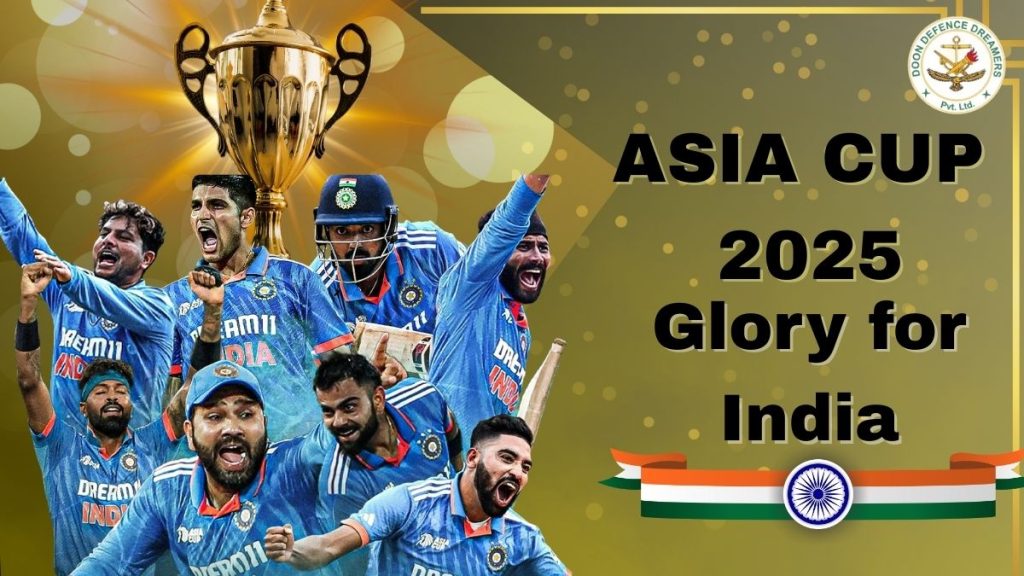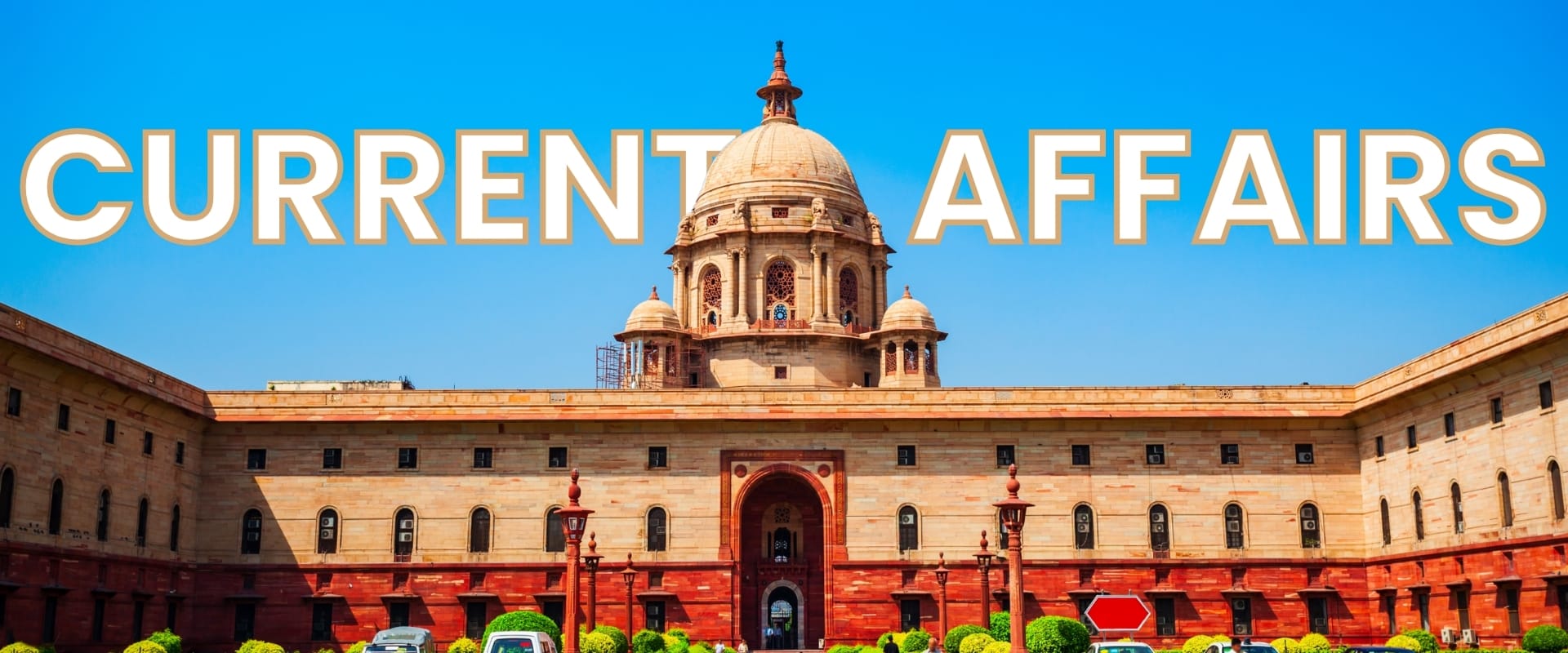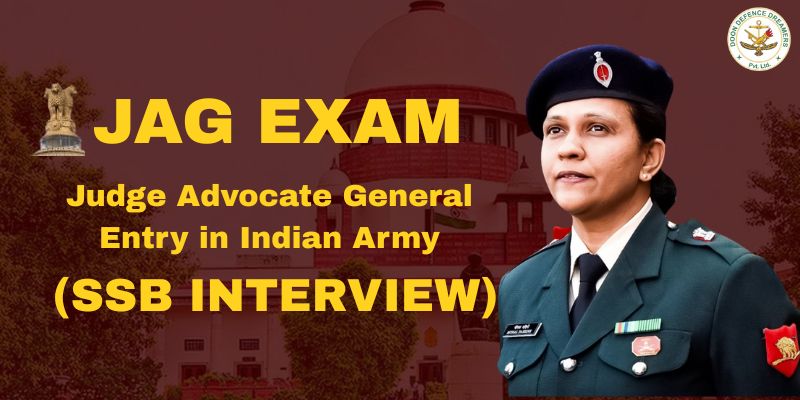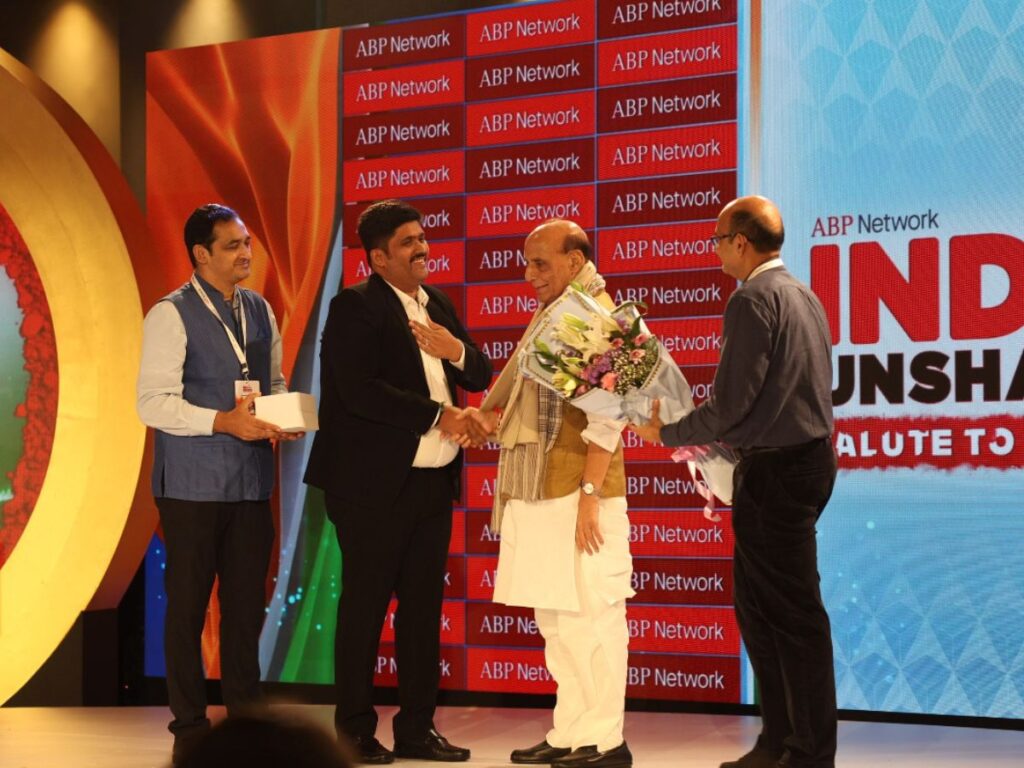India created history in the ACC Asia Cup 2025 with a thrilling 5-wicket victory over arch-rivals Pakistan in the final. This remarkable win in the India vs Pakistan clash definitely establishes India’s dominance in the tournament. The team has now won four of the last five Asia Cup competitions, further cementing their status as the powerhouse of Asian cricket.
The Indian team dominated throughout the eight-team ACC Asia Cup cricket tournament. Their impressive performance extended their unbeaten streak to 17 completed T20Is in multi-nation tournaments since 2023. Tilak Varma shone in the Asia Cup final with a significant unbeaten 69 off 53 balls. Kuldeep Yadav’s devastating spell of 4/30 dismantled Pakistan’s batting lineup. Abhishek Sharma topped the tournament’s run charts with 314 runs, and Kuldeep Yadav led the bowling statistics with 17 wickets (Asia Cup 2025). The BCCI rewarded this outstanding achievement with a ₹21 crore cash award for the players and support staff.
India’s Journey to the Asia Cup 2025 Final
Our Asia Cup 2025 campaign started with total dominance that set the stage for an unforgettable tournament. The team’s trip to their ninth title showed exceptional skill, determination, and tactical brilliance throughout the competition.
Group stage victories and key moments
We were spectacular in the group stage. The Asia Cup 2025 began with a dominant 84-run win over Nepal. Abhishek Sharma made his presence felt with a blistering 89 off just 47 balls. He smashed 7 sixes and 6 fours at a strike rate of 189.36. His explosive batting helped India post an imposing 196/6.
Our bowlers took control against UAE. Kuldeep Yadav bamboozled the opposition batsmen with 3 wickets while giving away just 14 runs in his four overs. UAE’s batting crumbled under pressure and they scored only 127 runs. We chased down the target easily with 8 wickets left and 26 balls remaining (Asia Cup 2025).
The best was yet to come in our India vs Pakistan clash. We posted a fighting 165/9 despite early pressure, thanks to Tilak Varma’s composed 48 off 36 balls. Our bowlers then put on a show defending a modest total. Kuldeep Yadav stood out again with 4 wickets for just 23 runs as Pakistan fell short at 146 all out. India won by 19 runs in this high-stakes India-Pakistan encounter.
Here’s how our stars performed in the group stage:
Abhishek Sharma: 184 runs at an average of 61.33
Kuldeep Yadav: 9 wickets at an economy rate of 5.75
Shivam Dube: 126 runs with a strike rate of 157.50
Super Four dominance and unbeaten streak
Our momentum grew stronger in the Super Four stage. We beat Bangladesh comprehensively in our first match. Abhishek Sharma stayed in great touch with 74 off 43 balls. Kuldeep Yadav kept taking wickets and finished with 3/29.
The Sri Lanka match turned into a thriller. We batted first and scored 179/6, with Rishabh Pant blasting 56 off 36 balls. Sri Lanka fought hard but tight bowling at the death, especially from Jasprit Bumrah (2/24 in 4 overs), got us a close 7-run win.
Abhishek Sharma didn’t slow down in the Super Four stage. He added 130 more runs to his tally. His fearless batting at the top gave us explosive starts that let our middle order capitalize.
Kuldeep Yadav’s magic with the ball got even better. He picked up 8 more wickets in the Super Four stage, taking his tournament total to 17. He kept breaking the opposition’s batting backbone in the middle overs.
Jasprit Bumrah hit peak form at the perfect time. His yorkers were almost impossible to score off at the death. He managed to keep an economy rate of just 6.25 throughout the Super Four stage despite bowling in tough situations.
We stretched our unbeaten run to 17 completed T20Is in multi-nation tournaments since 2023 by the end of Super Four stage. The team showed they could win consistently in any condition against any opposition. These clinical performances set up an exciting final against Pakistan, who bounced back from their group stage loss to make it to the championship match.
The team showed both individual brilliance and perfect teamwork on their way to the final. Our batsmen put up good scores, bowlers worked together, and fielding standards stayed high throughout. Different players stepped up when needed, showing just how deep and versatile this Indian cricket team is.
| Match Stage | Opponent | India’s Score | Opponent’s Score | Result / Margin |
|---|---|---|---|---|
| Final | Pakistan | 150/5 (19.4 overs) | 146 all out (19.1 overs) | India won by 5 wickets |
| Super Fours | Bangladesh | 168/6 (20 overs) | 127 all out (19.3 overs) | India won by 41 runs |
| Super Fours | Pakistan | 142/4 (18.2 overs) | 141/8 (20 overs) | India won by 6 wickets |
| Group A | Pakistan | 132/3 (17.5 overs) | 131 all out (19.4 overs) | India won by 7 wickets |
| Group A | Oman | 165/7 (20 overs) | 144/9 (20 overs) | India won by 21 runs |
| Group A | UAE | 102/1 (12.3 overs) | 101 all out (18.5 overs) | India won by 9 wickets |
The Final Match: A Battle of Nerves
The stage was set for a historic showdown as India and Pakistan faced off in the Asia Cup 2025 final. This nail-biting Ind vs Pak contest tested players’ and fans’ nerves alike. The game’s momentum swayed back and forth, creating an emotional rollercoaster that became one of the most memorable finals in tournament history.
Early setbacks and recovery
India’s chase of a modest 147-run target started disastrously. Our world-beating batting lineup crumbled to 20/3 inside four overs. Tournament sensation Abhishek Sharma’s law of averages caught up with him as he fell for just 5 runs to Faheem Ashraf in the second over. Captain Suryakumar Yadav soon departed for a single run, thanks to Pakistan skipper Salman Agha’s brilliant catch off Shaheen Afridi’s bowling.
Vice-captain Shubman Gill’s wicket fell next, leaving India in deep trouble. The required run rate kept climbing steadily, adding to the mounting pressure. Sanju Samson and Tilak Varma joined forces at the crease and tackled this challenging situation with remarkable composure. They built a significant 57-run partnership off 50 balls. The duo played spinners off the back foot and stayed away from premeditated shots.
Pakistan’s bowlers managed to keep disciplined lines, making runs hard to come by. All the same, Samson scored a valuable 24 off 21 balls before Abrar Ahmed dismissed him in the 13th over. India still needed 69 more runs with just six wickets remaining.
Tilak Varma and Dube’s match-winning stand
Shivam Dube joined Tilak Varma at the crease, and together they crafted an extraordinary comeback. Their game-changing fifth-wicket partnership produced 60 runs off just 40 balls. Dube’s significant 33 off 22 deliveries complemented Tilak’s measured aggression perfectly.
Haris Rauf’s 15th over changed the game completely. Dube and Tilak launched a calculated attack, hitting two fours and a six to collect 17 vital runs. This assault brought down the required rate from 10.66 to 9.4, putting India firmly in control. The equation changed from 64 off 36 balls to a more achievable 47 off 30.
Tilak Varma showed incredible mental strength throughout the chase, staying calm under pressure. His unbeaten 69 off 53 balls, featuring four sixes and three fours, ranks among the gutsiest knocks in Asia Cup history. This innings stands as the second-highest individual score in T20 Asia Cup finals by any player batting at position four or lower.
India’s successful chase of 127 runs after losing their third wicket became their second-highest in T20I history from such a position.
Dube fell with nine runs needed off six balls, but Rinku Singh stepped up to hit the winning runs off his first delivery, sparking wild celebrations in the Indian camp.
Pakistan’s collapse after strong start
Pakistan’s innings earlier had two distinct phases. Their start looked promising as openers Sahibzada Farhan and Fakhar Zaman built a solid 84-run partnership. Farhan raced to his fifty off 35 balls, while Zaman supported well with 46 off 35.
Pakistan looked set for a big total at 113/1 in the 13th over with 44 balls left. Captain Suryakumar Yadav seemed unsure about his bowling options.
Their innings fell apart dramatically from this strong position. A spectacular collapse saw their last nine wickets fall for just 33 runs in 39 deliveries—marking Pakistan’s lowest runs added by their last eight partnerships in any men’s T20I.
Varun Chakravarthy emerged as India’s match-winner by removing both set batsmen—Farhan for 57 and Fakhar for 46. Kuldeep Yadav bounced back impressively after a rough start where he leaked 23 runs in his first two overs, ending with figures of 4/30.
Kuldeep’s 17th over proved devastating as he claimed three wickets—Salman Agha, Shaheen Afridi, and Faheem Ashraf—in quick succession. Axar Patel and Jasprit Bumrah chipped in with two wickets each, bowling Pakistan out for 146 in 19.1 overs.
This brilliant bowling display set up what became one of the most thrilling yet satisfying victories in India’s Asia Cup history.
Heroes of the Tournament
The Asia Cup 2025 saw three outstanding players lead India to their ninth title. Each player’s contribution proved vital to the team’s success.
Abhishek Sharma: Player of the Series
This 25-year-old opener dominated the tournament as its most lethal batsman. He scored 314 runs in seven innings with a strike rate of 200 and an average of 44.85. His consistency showed through three back-to-back half-centuries in the Super Fours stage. The explosive batting style set India’s pace in every match, which earned him the coveted Player of the Tournament award.
His exceptional performance brought him three individual awards:
Player of the Tournament
Most Runs in the Tournament (314)
Most Sixes in the Tournament
“Getting a car is always a pleasure. Getting into this team after winning the World Cup was not easy for any opener. We had a plan to play our game and show our intent from the first ball. Worked really hard on that,” Abhishek said after receiving his award.
The left-handed powerhouse thanked captain Suryakumar Yadav and the coaching staff for supporting his aggressive batting style. “If you play like this, you need special support from the coach and captain, and that is what I have been getting,” he added. He scored just five runs in the final against Pakistan before Faheem Ashraf dismissed him. Yet his previous scores of 34 and 74 against the same team helped India secure their victory.
Kuldeep Yadav: Spin wizard
Kuldeep Yadav became the tournament’s best bowler with a record-breaking 17 wickets in seven matches. The wrist-spinner broke the previous record of 11 wickets in a single Asia Cup edition, set by Bangladesh’s Al-Amin Hossain in 2016.
His tournament stats showed an economy rate of 6.27 and an average of 9.29. These numbers earned him the Most Valuable Player award. He made history as the first spinner to take four three-wicket hauls in one series or tournament.
The final against Pakistan showcased Kuldeep’s brilliance. Despite an expensive start, he bounced back to take four wickets for just 30 runs. His game-changing 17th over saw him destroy Pakistan’s middle order with three wickets.
Kuldeep surpassed Sri Lankan star Wanindu Hasaranga’s record of most wickets (16) by a spinner from a full-member nation in a T20I series. This achievement put him on par with pacers Arshdeep Singh and Fazalhaq Farooqi for most wickets in a T20I tournament.
Tilak Varma: Calm under pressure
The Asia Cup final belonged to 22-year-old Tilak Varma. His unbeaten 69* off 53 balls, with three fours and four sixes, guided India to victory. India struggled at 20/3 when he walked in, but his composure steadied the ship.
His partnerships proved game-changing. He built a 57-run stand with Sanju Samson off 50 balls, followed by a 60-run partnership with Shivam Dube in 40 deliveries. These partnerships shifted the game’s momentum toward India.
The match turned in the 15th over. Tilak and Dube attacked Haris Rauf, hitting two fours and a six. This assault brought down the required rate from 10.66 to 9.4.
Tilak’s sprint toward his teammates after the winning runs showed his emotional investment. “Every shot spoke of timing, patience, and audacity—a perfect blend for a final charged with emotion,” one observer noted. The Player of the Match award in the final confirmed his ability to deliver under pressure.
Trophy Controversy and Political Undertones
A celebration turned into a diplomatic crisis at the Asia Cup 2025 post match presentation ceremony. India’s victory over Pakistan led to an unexpected confrontation over the trophy itself.
Why India refused to accept the trophy
The situation became tense when Indian players declined the Asia Cup trophy and medals during the post match presentation ceremony, which started an hour late. Asian Cricket Council (ACC) chairman Mohsin Naqvi, who also serves as Pakistan Cricket Board chairman and Pakistan’s Interior Minister, stood at the center of this controversy.
BCCI Secretary Devajit Saikia explained this was a calculated decision. “We cannot accept a trophy from a person who represents a country that is openly hostile and waging war against our country”. The Indian team had made it clear they would only accept the trophy from a neutral ACC or match official.
The players told organizers they wouldn’t appear on stage if Naqvi tried to present the trophy. This stance wasn’t sudden—the Indian team had stuck to a “No Handshake” policy with Pakistan throughout the tournament. They avoided handshakes with Pakistani players in all three Asia Cup matches and stayed away from the pre-toss photoshoot.
Reactions from ACC, PCB, and BCCI
The situation reached a breaking point when India stood firm. Announcer Simon Doull addressed the audience: “I have been informed by the ACC that the Indian cricket team will not be collecting their awards tonight. So that does conclude the post match presentation”.
Naqvi’s response was unprecedented—he left the stadium with the trophy and medals. BCCI’s Saikia called this action “very unfortunate and unsporting”. He announced India would raise “a serious and very strong protest against the act of the ACC chairperson” at November’s ICC conference in Dubai.
Pakistan’s captain Salman Agha defended Naqvi’s position. “If the ACC President is there, he will give away the trophy. If you don’t want to take the trophy from him, then how will you get the trophy?”. He suggested India had disrespected cricket rather than Pakistan.
Symbolic gestures and public sentiment
India’s team spirit remained unbroken despite missing the official trophy. Captain Suryakumar Yadav and his teammates celebrated with a mock trophy, showing that their achievement surpassed the physical award.
Suryakumar later shared a photo on social media. It showed him and Tilak Varma holding an AI-generated Asia Cup 2025 trophy with the caption: “When the game is done, only the champions will be remembered and not the picture of a trophy”.
The stadium crowd made their feelings clear. They chanted “Bharat Mata ki Jai” and jeered as Naqvi stepped onto the stage. Pakistan’s skipper Salman Ali Agha faced similar treatment from the crowd.
The incident quickly surpassed sporting boundaries and reached India’s political sphere. Prime Minister Narendra Modi’s congratulatory message had military undertones: “#OperationSindoor on the games field. Outcome is the same – India wins!”. BJP IT cell chief Amit Malviya supported the team’s decision, describing Naqvi as a “chief propagandist for the terror state that Pakistan is”.
This event reinforced how cricket matches between these neighboring nations remain deeply intertwined with their complex political relationship. The handshake controversy and trophy refusal added another layer to the already tense India-Pakistan rivalry.
Celebrations, Rewards, and Fan Reactions
The aftermath of India’s Asia Cup 2025 victory sparked massive celebrations, despite the trophy controversy making headlines. The team created unique ways to celebrate their achievement and received substantial financial rewards.
BCCI’s ₹21 crore prize announcement
The Board of Control for Cricket in India (BCCI) rewarded the victorious team with an impressive ₹21 crore prize money that included the support staff. BCCI Secretary Devajit Saikia described it as “a big reward for our team and the Indian cricket board as well as the people of India”.
The board kept the exact distribution details of the fund under wraps. The BCCI’s social media announcement took a bold stance on India’s supremacy over their rivals: “Three blows. 0 response. Asia Cup Champions. Message delivered. 21 crores prize money for the team and support staff”.
BCCI Vice President Rajeev Shukla celebrated the victory: “The undefeated champions of ASIA. Congratulations Team India on a dominating win and 3-0 against Pak. Marvelous display by Tilak Verma and @imkuldeep18. A great show under pressure”.
Imaginary trophy celebration
The players turned the trophy controversy into a moment of creativity. Suryakumar and his teammates lifted an invisible trophy during their podium celebration. This spontaneous gesture became one of the most shared moments on social media.
The captain recreated Rohit Sharma’s signature celebration style with a slow walk toward the team before letting out a victory roar. Shubman Gill, the vice-captain, added his touch by sharing a photo with Abhishek Sharma that featured a digital trophy between them.
Hardik Pandya, who sat out the final due to injury, joined the fun by posting a photoshopped trophy image on his social media.
Social media and stadium reactions
Celebration posts took over every major social platform. Users filled Instagram, Twitter, and Facebook with congratulatory messages, creative memes, and match highlights. “India trophy boycott” and “imaginary trophy” became global trending topics after the final.
India’s celebrity circle embraced the victory celebrations. Amitabh Bachchan, Sidharth Malhotra, and Malayalam superstar Mammootty led the online tributes. Sidharth Malhotra captured the nation’s mood perfectly: “What a match tonight! India showed grit, fire & heart. Unbeaten champions! You make us all proud”.
The Dubai International Stadium buzzed with energy as fans filled every seat, their cheers echoing through both the match and the unique victory celebration. Many fans followed the live cricket score updates on various platforms, adding to the excitement of the India vs Pakistan clash.
Records and Legacy of Asia Cup 2025
The Asia Cup 2025 didn’t just end with a trophy presentation – it created several amazing records in cricket history. Let’s get into the statistical milestones that made this tournament special.
India’s 9th Asia Cup title
India grabbed their ninth Asia Cup title by beating Pakistan, which makes them the most successful team in tournament history. The team’s impressive collection now has seven ODI format titles and two T20I titles. India has won four of the last five Asia Cups (2016, 2018, 2023, and 2025). Their grip on this continental championship stands unmatched. Sri Lanka follows with six titles while Pakistan has just two.
Unbeaten streak in multi-nation T20s since 2023
India’s perfect run in the Asia Cup 2025 stretched their amazing winning streak in multi-nation T20 tournaments to 17 straight matches since 2023. This incredible journey has two wins from the 2023 Asian Games, eight victories in the 2024 T20 World Cup, and seven wins in the 2025 Asia Cup. India became the first team to win a T20 World Cup without losing a single match and kept this momentum going into the Asia Cup.
Historic wins over Pakistan
India’s dominance over Pakistan has reached new heights. The team’s success rate against Pakistan in T20Is now stands at 81.25%. India’s record shows a perfect 9-0 score when chasing targets against Pakistan in T20Is – no other team has achieved this against any opponent. This victory improved India’s win-loss record against Pakistan in finals to 5-8 across formats. Kuldeep Yadav added another milestone by taking 17 wickets, the most in a single Asia Cup edition, breaking the old record of 11.
Conclusion
India’s Asia Cup 2025 victory proves our cricket team’s exceptional skill, mental strength, and dominance in Asian cricket. Our players showed amazing consistency and stayed calm throughout, which helped extend their unbeaten run to 17 completed T20Is in multi-nation tournaments since 2023.
Abhishek Sharma batted explosively while Kuldeep Yadav broke bowling records. Tilak Varma delivered match-winning performances when the pressure was highest. Their brilliant individual play and strong team spirit helped us overcome every challenge, including a tense final against Pakistan.
The trophy controversy after our win couldn’t take away from the joy of securing our ninth Asia Cup title. The team turned this around by celebrating with an imaginary trophy, which showed how well they could handle challenges both during and after matches.
BCCI rewarded this massive achievement with ₹21 crore. The nation celebrated wildly as fans filled social media with congratulatory messages and creative memes that captured everyone’s joy.
This win adds another bright chapter to our cricket’s story. We’ve now won four of the last five Asia Cup tournaments, which confirms our place at the top of Asian cricket. Our perfect 9-0 record against Pakistan while chasing targets shows we’re nowhere near our continental rivals.
This Asia Cup victory will be remembered for more than just broken records and spectacular performances. The team’s steadfast dedication turned even controversy into a chance to show their character. The cup belongs right here at home, cementing India’s status as the cricketing powerhouse of Asia.
If you want to stay updated with quality current affairs, defence-related insights, and exam guidance, make sure to regularly visit Doon Defence Dreamers. It is known as one of the best NDA coaching institutes in Dehradun, helping aspirants shape their future with the right guidance and strategy.
From NDA and CDS preparation to AFCAT, and SSB interview training, Doon Defence Dreamers provides a complete ecosystem for defence exam aspirants. With expert faculty, disciplined learning, and proven results, it continues to inspire students to achieve their dreams of joining the armed forces.






























